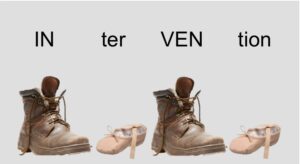102C. Recognizing primary & secondary STRESS
If you read section 102A, you saw that some syllables get stressed, while others do not. In section 102B, you saw that some words get stressed, while others do not. That means that the STRESSED syllables within STRESSED words get double STRESSED.
This might seem complicated, but it’s actually really simple, and you do it every time you speak. Look at the examples below and you will see that you are already naturally capable of speaking with different levels of stress.
PRIMARY AND SECONDARY STRESS
 Words with three or more syllables have a PRIMARY stressed syllable and a SECONDARY stressed syllable in addition to at least one UNstressed syllable. There are some schools of scansion that believe there are Tertiary STRESSED syllables, etc. But for the purpose of writing Meter, it isn’t important to determine successive levels of STRESS. But it is important to know that levels of STRESS exist. PRIMARY and SECONDARY STRESS will be important when you get to 105. Metrical Lines.
Words with three or more syllables have a PRIMARY stressed syllable and a SECONDARY stressed syllable in addition to at least one UNstressed syllable. There are some schools of scansion that believe there are Tertiary STRESSED syllables, etc. But for the purpose of writing Meter, it isn’t important to determine successive levels of STRESS. But it is important to know that levels of STRESS exist. PRIMARY and SECONDARY STRESS will be important when you get to 105. Metrical Lines.
Look at the word INTERVENTION:
This word has two STRESSED syllables: IN & VEN.
And two UNstressed syllables: ter & tion.
But if you listen carefully, the syllable that is stressed the most, is VEN. So, VEN is the primary STRESSED syllable and IN is the secondary STRESSED syllable.
LEVELS OF STRESS
So if you were speaking to your best friend and you wanted to emphasize that your son has baseball practice today and not tomorrow, the word [today] would be stressed. But the last syllable of [today] would have even an extra level of STRESS.
Johnny has baseball practice today.

To understand how STRESSED and UNstressed syllables make up Metrical Feet see 103 Metrical Feet


